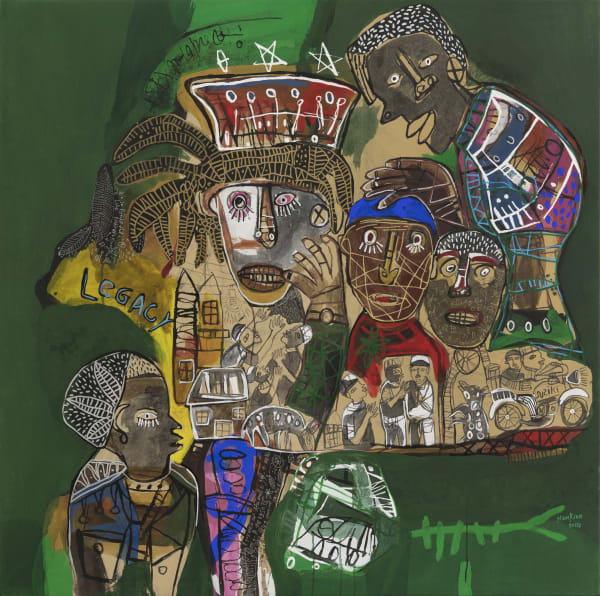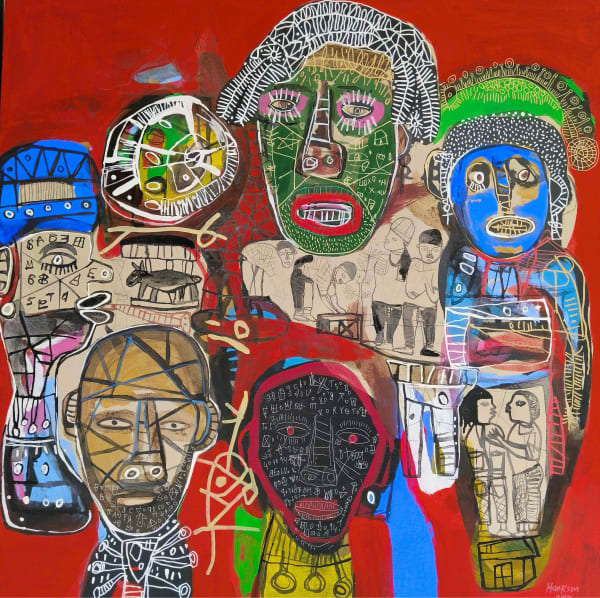The urgency of thought: Hako Hankson
Past exhibition
Press release
Hako Hankson
The urgency of thought
Born in 1968 in Bafang, Cameroon, Hako Hankson now lives and works in Douala. A self-taught artist, whose real name is Gaston Hako, with a diploma in car mechanics, was promised a completely different future. However, he chose painting and the elements that forged his youth.
Hako Hankson’s approach is to help and learn from his peers, it’s a true ode to the past and myths of ancient African civilizations. The artist transcribes, with legitimacy, the history of ancestral rites by giving them a contemporary resonance
Hako grew up under the influence of the art and culture of the sources of his country. His father was a notable person in Cameroon and also a sculptor and musician of the Royal Palace. Hako was therefore brought up surrounded by objects of initiation rites: masks, statuettes, totems etc.
Hako has created a reception centre and a place of residence for visual artists facing difficulties, this structure, called “In and off art center”, was inaugurated in 2013 by his own means.
____________________________________
Hako Hankson's works possess an essential recognisability, the use of masks, tribal figures, the careful choice of colours and the abundance of details and decorations make his works a concentration of Africa. They are distinct and carefully delineated elements that narrate, through expressions and compositions, the cultural history of this continent.
The use of masks stems from a profound philosophy of life, practised and recognised by Hako Hankson, handed down to him by his father: animism.
"My father, for his part, drew me into animist beliefs: for example, by using masks and statuettes in a dialogue with the afterlife, and that's how I came to understand the power of masks, what they could carry as a spirit, a soul, something subtle that we can't control".
His works have an intrinsic narrativity, in fact, although the viewer sees well-defined elements, plots and fantasies develop on the canvas enriching the aesthetic beauty of the masks. One often comes across human figures, convivial scenes depicted as if they were small visions within the works themselves. This indicates a link that Hako Hankson has always wanted to express: animism uses elements, such as masks, to converse with the afterlife and thus take on a spiritual, as well as an earthly character, acting as a bridge between soul and body.
In the artist's canvases there appear flashes of humanity, encounters, human figures in their own right, or other elements, even animals, which always strictly maintain an almost rupestrian line of representation.
In fact, Hako Hankson's works also turn their attention to the past, underlying which is an important creative study of ancient African graphic descriptions. Not far removed from what are, for us, rupestrian paintings. In this way, the artist expresses a strong attachment to his own land, communicating it to Africans, showing their shortcomings and problems, almost in a codified language that, only thanks to a strong globalisation, becomes familiar to us too, reminding us of American or European artists who, appropriating a very similar imagery, revolutionised western aesthetics. In his works, the artist describes what has always surrounded him, through a universal language that is as clear as it is intricate.
He goes back to his origins, narrating different situations and characters, as humanity once did, but he evolves his language, enriches it and complicates it to make it futuristic. So as to attract the interest of the viewer, who loses himself in the immensity of the details.
Hako Hankson's painting addresses his homeland, but at the same time he wants to export what he sees as contemporary Africa to the world, narrating it through elements of what Africa once was, while maintaining its tribal nature. It is a message of hope, a new language that can lead the African continent to a better future.
Installation Views
Works
-
 Hako Hankson, The journey of the soul, 2024
Hako Hankson, The journey of the soul, 2024 -
 Hako Hankson, The laws of the palace, 2024
Hako Hankson, The laws of the palace, 2024 -
 Hako Hankson, The bark and the tree, 2024
Hako Hankson, The bark and the tree, 2024 -
 Hako Hankson, We are sorry , 2024
Hako Hankson, We are sorry , 2024
Video










